

The following article was adapted from "1909 Mafia murder in Danbury, Connecticut," published in the July 2009 issue of Informer: The History of American Crime and Law Enforcement, "1909 Mafia Murder in Danbury Remarks by Thomas Hunt" and its companion images booklet from a presentation at Danbury Museum & Historical Society, Oct. 8, 2009.
Local fruit farmer Giovanni Zarcone ended his visit to the hospital in Danbury, Connecticut, just before eight-fifteen in the evening and started on his short walk home. The date was Tuesday, July 27, 1909. It was already dark – Daylight Saving Time was not yet in use. The sun had set about an hour earlier.
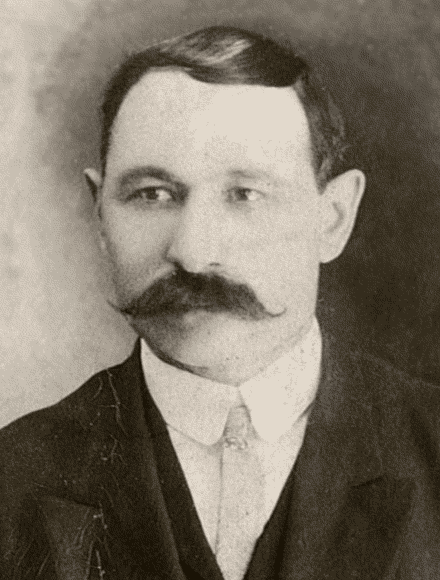
Giovanni Zarcone
A halo of artificial light surrounded the hospital, a complex Victorian-style structure located at the intersection of Locust and Hospital Avenues (approximately where the South Building of the hospital campus stands today). A bit of light also emanated from the city's almshouse a third of a mile further east at Broadview farm, later location of the city's Broadview Middle School.
In between, Zarcone's route home was illuminated only by the quarter moon almost directly overhead. Moonlight was sufficient to provide visibility on the roadway itself, but it did not penetrate the tree branches and dense brush growing along the north side of the street.
Zarcone headed east on Hospital Avenue. His destination – a home he shared with his wife, their children, some grandchildren and in-laws – stood at the northeast corner of Hospital and Forest Avenues. (The home outlived Zarcone by more than one hundred years before being torn down.)
Within a minute or two, people in the area were startled by shotgun blasts and screams. Danbury Hospital Superintendent Susanna Cutler rushed to the telephone and called police headquarters. Police Captain David Bradley dispatched Officers James Turner and Felix Dougherty to Hospital Avenue to see what was going on.
The residents of the Zarcone home, experiencing the unnerving sensation that the noises outside were getting closer, threw open their door and stepped into the yard. They spotted a number of dark figures running westward into the Tamarack woods.
On the ground at their feet was the dead body of the fifty-two-year-old family patriarch. The side of Giovanni Zarcone's head had been split open by the discharge of a shotgun at close range. The lower part of his face had been torn away by the exiting shot. Additional wounds were visible on the body's back and left side.
Officers Turner and Dougherty found their way to the Zarcone home, learned of the murder and telephoned back to the police station with a disturbing message: A Zarcone son-in-law believed he counted as many as seven armed men running into the woods.
Captain Bradley sent additional officers to Hospital Avenue, instructing them to search the surrounding area. He then met with Mayor William Gilbert at City Hall. (In that period, Danbury's City Hall was the focus of the local business district. The building, a massive stone and brick structure with a tall clock tower, stood for many years overlooking the intersection of Main and West Streets. The public library's plaza now occupies that corner. A portion of the rear wall of that former city hall building has been preserved at the back end of the plaza, dividing it from an adjacent driveway.)
Understandably alarmed at the prospect of a small army of assassins wandering the countryside, Mayor Gilbert summoned assistance through the use of the fire alarm box outside of City Hall. A ten-stroke alarm was sounded, bringing out regular and volunteer firefighters, special police officers and a crowd of curious residents. City officials borrowed a number of automobiles to quickly transport men the one and a third miles to the murder scene. Others were deployed through the use of a horsedrawn "carryall" carriage.
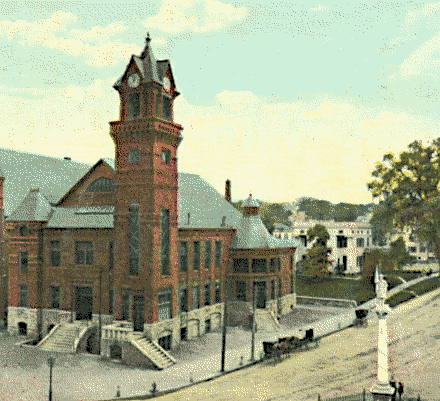
City Hall
With permission from Connecticut Governor Frank Benton Weeks, Mayor Gilbert put to work the Danbury-based Eighth Company, Connecticut Coast Artillery, commanded by Captain Clarence Judson.
By ten-thirty, Judson's militiamen, carrying loaded rifles, began taking positions on Tamarack, Hayestown and Great Plains Roads, effectively surrounding the vast wooded area behind the Zarcone farm. By midnight, dozens of Judson's men were manning roadblocks and aiding police in a search of the Tamarack woods.
The measures were well conceived but poorly timed. If the murderers of Giovanni Zarcone had devised any reasonable escape plan, they would have been out of the area long before the roads were blocked.
At a late hour, Mayor Gilbert and Captain Bradley borrowed an automobile and began a drive to South Norwalk. They returned about three o'clock the next morning in the company of Detective Leo Donnatel of the state's attorney's office. Donnatel's presence added experienced eyes and ears to the murder investigation. Near dawn, as traffic around the city increased, militiamen were taken from their search of the woods to aid in road picket duty. At nine, they were withdrawn from the area. It was apparent to all that the murderers of Giovanni Zarcone had escaped.
On Wednesday and Thursday, July 28th and 29th, newspapers across the country reported the murder of an Italian farmer in Danbury.
There was nothing especially unusual about the reporting of a Mafia killing – stories like that already had been appearing in print for decades. And it wasn't strange for Danbury's name to pop up in newspapers. Since the Revolutionary War, Danbury had found ways of getting media attention. In this period, it was regularly in the headlines due to the antitrust action brought by hat manufacturers against unions and unionized workers in the city.
But a couple of things made the Zarcone murder story unique. The combination of Danbury and a Mafia murder certainly was out of the ordinary. And there was a strange element in the reporting of the story. While Mafia killings of the time typically remained unexplained for weeks, for months, or in some cases forever, the media seemed instantly – though a bit vaguely – to know who was behind the killing of Zarcone. In some of the very first stories published about the murder, newspapers reported that Zarcone was shot to death because of his involvement in the 1903 New York City Barrel Murder.
Just how reporters were able to quickly link the news from Danbury with an event that occurred six years earlier and seventy miles away is a question that has never been answered.
If the media reports were accurate, then to make sense of the 1909 Mafia murder in Danbury, we need to turn the clock back further and look into Giovanni Zarcone's background and his relationship to the infamous Barrel Murder.
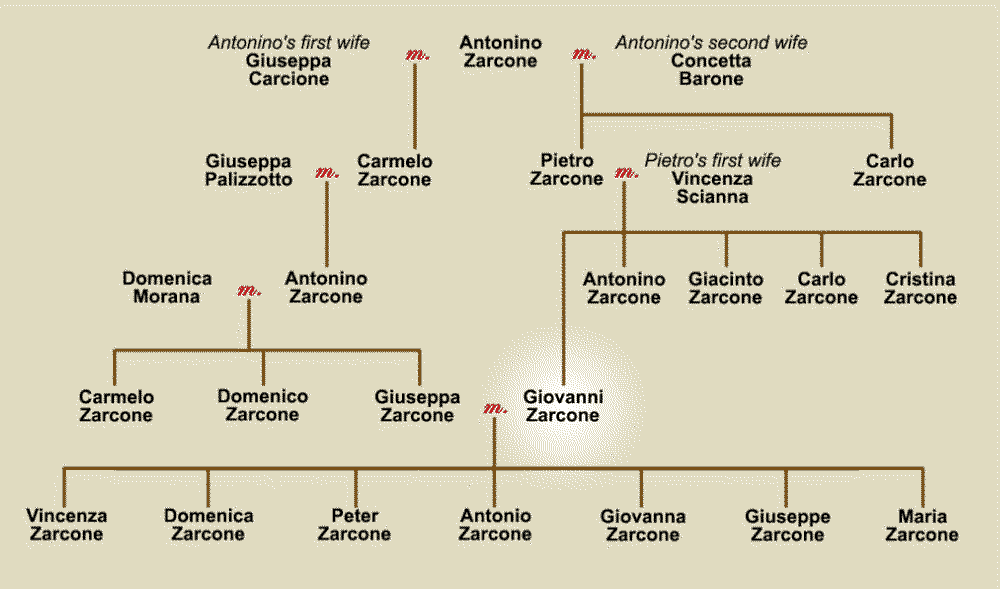
Family tree
Giovanni Zarcone's family was rooted in Sicily, specifically in and around the clustered towns of Bagheria, Villabate and Santa Flavia, southeast of Palermo. He was born in 1857 to Pietro and Vincenza Zarcone of Bagheria. He was the youngest of several sons born to the couple. His mother died when Giovanni was a young adult, and his father remarried. Like a number of other family members, Giovanni worked as a butcher.
A few years after the birth of a half-brother, Giovanni started a family of his own. In 1882, he married a distant relation, Giuseppa Zarcone. Through the next seventeen years, the couple had seven children – four daughters and three sons.
In 1901, Zarcone ventured across the Atlantic just as he turned forty-four years old. While many other Sicilians resettled in America to escape poverty or oppression, his voyage may have been the result of marital infidelity. A story passed down through generations of the family indicated that Zarcone's relatives compelled him to make a new home for himself and his growing family in the United States in order to put an end to a longterm adulterous relationship in Sicily.
If that was true, the strategy seems to have been a failure. In fact, Zarcone sailed to the U.S. in the company of a twenty-six-year-old woman named Gaetana Giardina, who seems to have identified herself for the ship's manifest as Zarcone's wife. The couple's first destination in the New World was the apartment of Gaetana's brother Ignazio Francis Giardina on Mulberry Street in New York City.
Shortly after their arrival, Ignazio Giardina moved north from New York and settled in Danbury, Connecticut. The western Connecticut city, located about fifty-five miles from New York, was then widely known as "Hat City" for its booming hat manufacturing industry. Ignazio Giardina's known home addresses in the city were on Locust Avenue, Granville Avenue and Balmforth Avenue. He worked as a barber and as owner of a barber supply company. Where his sister Gaetana Giardina lived in this period is uncertain.
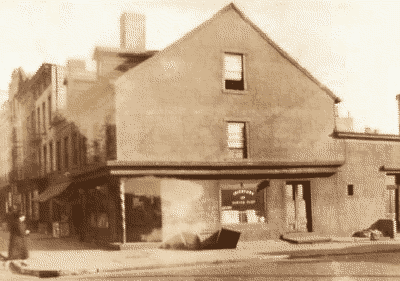
50 Main Street
Giovanni Zarcone soon established a home for himself and his family at 50 Main Street in Brooklyn, between the Brooklyn Bridge and the then under construction Manhattan Bridge. The area is known today as "DUMBO," for "Down Under the Manhattan Bridge Overpass."
The Main Street apartment was a couple of miles from the address of several Zarcone relatives on Fourth Avenue in Brooklyn. In the summer of 1902, Zarcone was joined at the Main Street residence by his wife Giuseppa and four of their children, Domenica (known as Minnie), Maria, Giuseppe and Antonino. The family soon moved about a half mile away into a six-unit apartment house on Brooklyn's Hudson Avenue, near Navy Street and the U.S. Navy Yard.
It was fortunate the Zarcones moved when they did. A short time later, their old home at 50 Main Street was raided by the United States Secret Service. Five men and one woman were arrested as members of a counterfeiting organization dubbed the "Society of the Bad Blood."
One of the men involved, Salvatore Bufalo, appears to have been an in-law of Giovanni Zarcone. The arrests did not go easily. While the Secret Service scuffled with the other people in the apartment, Bufalo jumped out of a window, taking much of the window with him. He was later caught by detectives as he boarded a ferry for Manhattan. Authorities linked the Bufalo group with counterfeit bills known as the "Morristown Fives." Those were phony bills copied from a five-dollar note issued by the National Iron Bank of Morristown, New Jersey.
Though no one mentioned it at the time, the Secret Service believed that a Manhattan-based Mafia organization run by Giuseppe Morello was behind the Morristown Fives. In addition to commanding the Manhattan Mafia, Morello held the exalted position of American Mafia capo dei capi - "boss of bosses."
The three remaining Zarcone children – Vincenza, Peter and Giovanna – crossed the Atlantic the next spring. Peter was reunited with his family at once, but the two girls' entry into the country was complicated by a health problem. Eightyear-old Giovanna was diagnosed at Ellis Island with trachoma, an infectious eye disease that disqualified her from admission into the U.S. Vincenza, twenty at the time, was also rejected for entry because she was the adult passenger officially responsible for Giovanna and would be needed to accompany the girl back to Italy.
Giovanni Zarcone fought the deportations, possibly making use of underworld connections in order to do so. He filed a habeas corpus writ in May. That was dismissed, as the government assigned his two daughters to the custody of the commissioner-general of immigration. Zarcone brought an urgent appeal to the U.S. Supreme Court. Before his case could be heard, doctors determined that Giovanna had made a full recovery. Zarcone then filed a second writ of habeas corpus and finally won the release of his girls. Immigration officials started to appeal that decision but then dropped the matter.
If the Zarcone family had only immigration matters to deal with, 1903 still would have been an extraordinarily challenging time. But the family had to deal with much more.
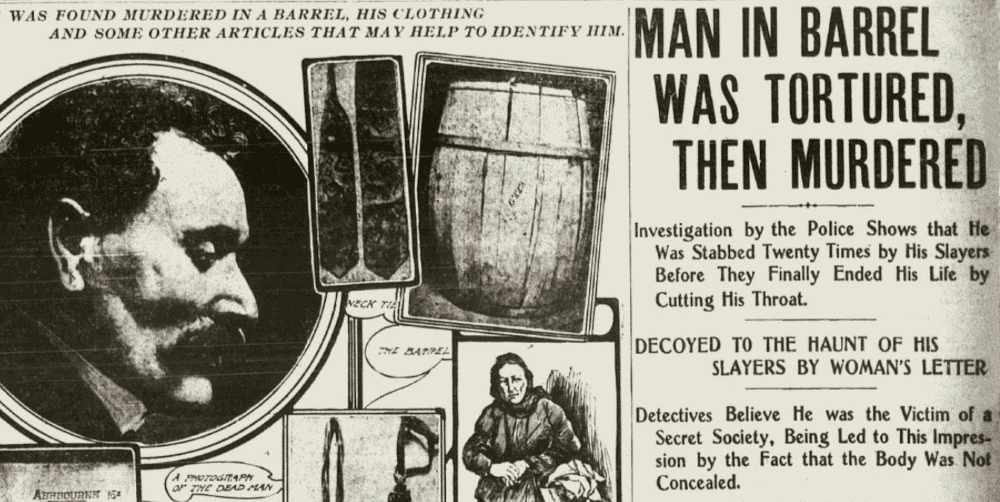
Coverage of Barrel Murder
Just two days before the ship carrying Vincenza, Peter and Giovanna entered New York harbor, the remains of a murdered Italian man were found within a barrel deposited on a Manhattan street corner. That discovery and the events that followed would haunt the Zarcones for years.
The body was found on a rainy morning, April 14, 1903, in front of 743 East Eleventh Street. The victim's throat had been cut from ear to ear, and other knife wounds were evident. Police had few clues to the man's identity, but the New York office of the U.S. Secret Service was able to help.
Secret Service Agents Henry Ritchie and George Burns reported that the man in the barrel closely resembled a stranger they had seen the previous night at a butcher shop on Manhattan's Stanton Street. Giuseppe Morello's Mafia organization, long suspected of manufacturing and distributing counterfeit American and Canadian currency, used that shop as a headquarters. Agents Ritchie and Burns and other Secret Service agents had been watching events at the butcher shop from an apartment across the street.
Once they received this information from the Secret Service, police immediately rounded up known members of the Morello Mafia. The initial suspects were Morello, his brother-in-law and chief lieutenant Ignazio Lupo, Tommaso "the Ox" Petto, Vito Laduca, Antonio Genova, and seven others. But, still, the police did not know who the victim was.

Flynn
Eventually William Flynn, chief of New York's Secret Service office, told the police of his strong suspicion that the murdered man was linked with three Morello associates recently imprisoned for passing counterfeit bills up in Yonkers. Acting on that lead, Detective Joseph Petrosino of the New York Police took a photograph of the barrel victim's face to Sing Sing Prison and showed it to the new prisoners.
Inmate Giuseppe DePrimo recognized the face as that of his brother-in-law Benedetto Madonia of Buffalo, New York.
Investigators decided that the recent convictions of DePrimo and his codefendants had triggered a falling out between the DePrimo clan and Morello's Mafia. With DePrimo safely locked away in Sing Sing, Morello resolved the disagreement by inviting DePrimo's brother-in-law Madonia to New York and making an example of him.
While the police were certain they knew what happened to Madonia, evidence was lacking. At that time, forensic science was in its infancy, and murder evidence was confined to witness testimony and whatever confessions the police were able to beat out of their suspects.
A coroner's jury decided that Madonia was killed by some unknown person or persons. While the jury did not charge the Morello group with murder, it ordered a number of the Mafiosi, including Morello, Petto, Laduca and others, held as accessories to the killing. The jury also decided that Giovanni Zarcone was an accessory.
Zarcone was part owner of the Stanton Street butcher shop and owner of a wagon believed to have been used to transport Madonia's remains. An arrest warrant was issued and Zarcone was picked up at his Hudson Avenue home.
Prosecutors did not have much of a case against the Morello mobsters, and most of them were quickly freed. On June 25, 1903, a grand jury indicted only Tommaso Petto for the Barrel Murder. And that was because police found a pawn ticket on Petto when he was arrested and linked it to a watch that had been owned by Madonia. The Ox remained in custody another seven months, as his trial was repeatedly delayed. Early in 1904, Petto was freed. Little explanation was given for the action, and even Petto's attorney was caught by surprise. The Ox didn't stop to ask any questions. He quickly gathered some belongings and left the city.
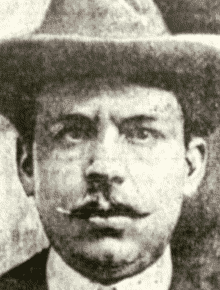
Petto
He was not the only one to leave. In fact, there was an exodus of Mafiosi from New York. Several of those who fled the city met with violent ends.
Petto settled in Browntown, in northeastern Pennsylvania. Using the name Luciano Perrino, he began extorting money from immigrant Italian families in the region. In October of 1905, Petto was shot to death in the doorway of his home. He was struck by five bullets. One of them passed through his right wrist as he drew a handgun and attempted to return fire. Police at first suspected that the murder was committed by DePrimo or some other relative of the murdered Madonia. William Flynn later ruled out DePrimo, noting that the counterfeiter's prison term was not up until shortly after Petto was slain.
While a vendetta arising from the Madonia murder seemed likely, authorities wondered if the Morello Mafia, growing increasingly paranoid due to incessant attention from law enforcement, might be moving against its own former members. Some theorized that the Mafia bosses wished to eliminate anyone who could connect them with the Barrel Murder. It is also possible that Petto's unexpected release from prison and his quick departure from New York were interpreted by Morello mobsters as evidence that the Ox was cooperating with authorities. Morello, Lupo and their families had good reason for worry at that time. The police and the Secret Service were swarming. One Morello relative noted that nearly every time he stepped out onto the sidewalk, he was frisked and questioned by police.
There is no way to know whether former Barrel Murder suspects fled the city because they feared prosecution or because they feared the increasing Morello paranoia. But Petto was just the first to be killed.
After emerging as a primary suspect in a New York kidnapping case, Vito Laduca relocated to Baltimore, Maryland, and became involved in racketeering there. After a short time, he returned to Sicily. Assassins apparently were on his trail, and he was killed early in 1908.
Moving to Dayton, Ohio, did not save Morello gangster Antonio Genova. He reportedly was killed in that Midwestern city a short time after Laduca's death.
With three Barrel Murder suspects shot down far from New York City (and one other alleged Morello gangster – a man named Mondini – killed within New York in the same period), major newspapers could have been on alert for similar incidents. This is one possible explanation for Zarcone's killing being so quickly linked to Madonia's.
Like Petto, Laduca and Genova, Giovanni Zarcone decided to relocate after winning his freedom. He first moved to the city of Bridgeport, a bustling industrial center at the southwest of Connecticut, by the start of 1905. There he opened a grocery store at the corner of Stephen and Pembroke Streets.
At least one of the Zarcone children remained behind in Brooklyn for a time. Minnie Zarcone was a resident of Washington Avenue in Brooklyn when she married her first cousin Francesco Zarcone in 1905. Francesco was the son of Giovanni Zarcone's older brother Carlo. (Marriage of cousins was not unusual in the Zarcone family of this era. Another of Giovanni's daughters, Vincenza, also married her first cousin.)
In 1905, Zarcone moved on to Danbury, the adopted home city of Ignazio Giardina. On September 27, Zarcone purchased a fifty-nine-acre farm on Hospital Avenue from Sarah Austin. In order to make the purchase, he arranged a $4,000 (equivalent to more than $120,000 in 2021) mortgage from Alice Jennings, a Bridgeport widow he probably met during his family's brief stay in that city.
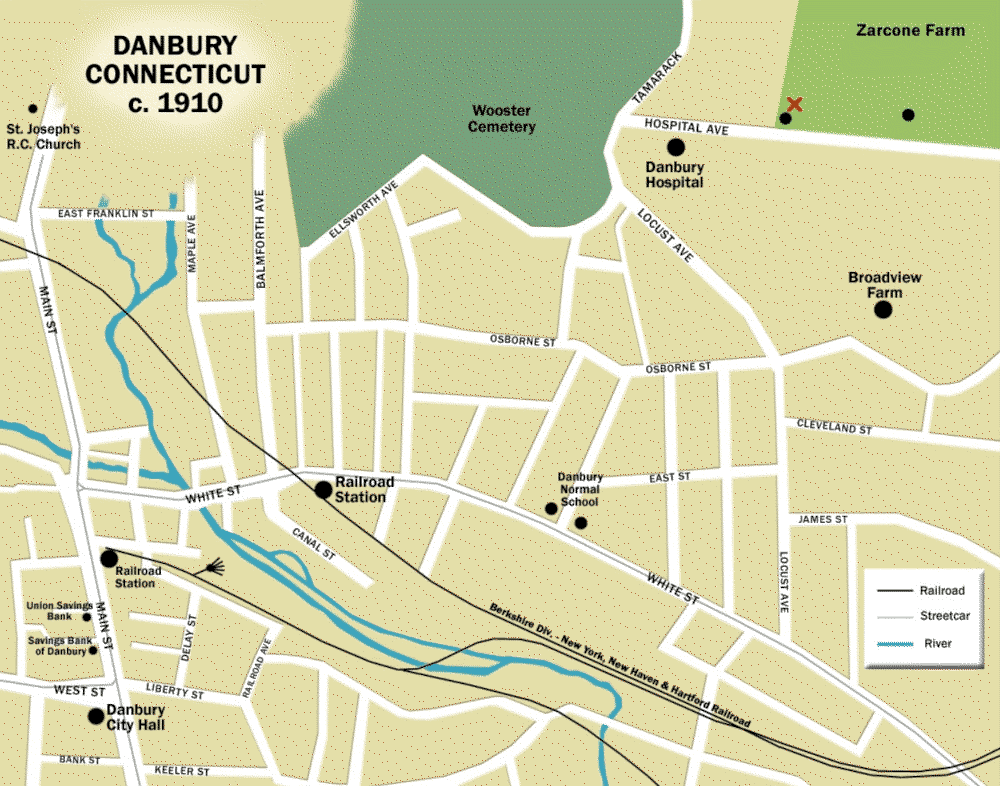
Danbury, Connecticut
In addition to being the worldwide center of the hat industry, Danbury also was an important railroad link, connecting factories and western Connecticut farmers with their markets. The city's population was more than 20,000 people, and its Italian-born community was growing rapidly.
Zarcone moved his wife and children into a recently constructed two-story home at the southwest corner of the farm property, as he began work converting a large barn into more spacious living quarters for his family.
The new Zarcone farm sat mostly along the north side of Hospital Avenue, opposite Broadview Farm. Near the eastern end of Hospital Avenue, the roadway turned north and then southeast, cutting off one small chunk of the farm property from the rest as it formed a threeway intersection with Osborne Street and Germantown Road.
Zarcone planned to grow an extensive variety of fruits on his new farm. He planted young peach trees close to the road. Behind those, he placed grape vines and other fruit and berry plants. He sold his produce at a retail market on White Street and gradually established a wholesale operation.
The Zarcone home, which probably provided about eleven hundred square feet of living space at that time, must have been crowded. In addition to themselves and their several unmarried children, Giovanni and Giuseppa opened their doors to daughter Minnie, her husband Francesco and their young son Carlo. Francesco was employed as a butcher, like so many other men in the Zarcone line.
But the residence would get even more crowded. In 1906, Gaetana Giardina showed up. She and Giovanni Zarcone apparently remained in touch since crossing the Atlantic together five years earlier. Giovanni introduced her to his wife Giuseppa, saying she was the widow of Giuseppa's brother who recently had died in a mining accident. It is uncertain whether there was any truth in the details of that story, but Giuseppa seems initially to have accepted it. The Zarcone family, welcomed the woman into the home.
Whether Giovanni Zarcone had hoped to keep his new location secret from his former underworld associates is unknown. But his address certainly was no secret by the autumn of 1906.
Giovanni's son Peter, then eighteen, was walking across a marshy area of the farm on Sunday, Sept. 23. He later claimed that he was trying to find a cow that had wandered away, though he did not explain why he was carrying a shotgun at the time. When Peter came upon a snake, he fired his shotgun at it. That drew the attention of a nearby policeman, who went into the woods after Peter and placed the young man under arrest.
In Danbury's courthouse, Judge Howard Scott found Peter guilty of violating Connecticut's "blue laws." Those laws specifically prohibited even the carrying of a firearm on a Sunday. Peter was fined $10 (equivalent to $300 in 2021). Newspapers across the country published stories about Peter Zarcone's fine and Connecticut's archaic Sabbath rules.
Press coverage focused on the oddity of Connecticut's law - one report joked that a Nutmeg State resident confronted with a snake faced a tough choice, as the sale of snake antivenom on Sunday was also outlawed. But there seems a good chance that Peter did not encounter the snake by accident and did not shoot it purely in self-defense. At the time, the State of Connecticut paid a bounty for the killing of timber rattlesnakes. Peter might have taken his shotgun into the woods in the hope of earning some cash. Money may have been a concern for the Zarcone family at the time.
The effect of Peter's Sunday adventure was widespread publicity for the presence of the Zarcone family in Danbury. The news story was featured prominently in papers as far away as Oakland California's Tribune.

Oakland, California, newspaper coverage
About a year after Peter's costly encounter with the snake, Giovanni Zarcone took out a $2,500 ($72,000 in 2021) mortgage on his property from the Savings Bank of Danbury. He paid off the remainder of the earlier loan from Alice Jennings and probably had some money left to invest in his farm business.
In this period, the Zarcone clan strongly linked itself through marriages to the Locascio family. Originally from the town of Altavilla Milicia in Sicily, just southeast of Bagheria, the Locascios had settled in the Chicago area. Giovanna Zarcone married Mariano Locascio. Peter Zarcone married Mariano's cousin Angela Locascio.
The marriage between Peter and Angela occurred at St. Joseph's Church in Danbury. Peter and his new bride moved out west to Chicago, while Giovanna and Mariano remained in Danbury at the Hospital Avenue home.
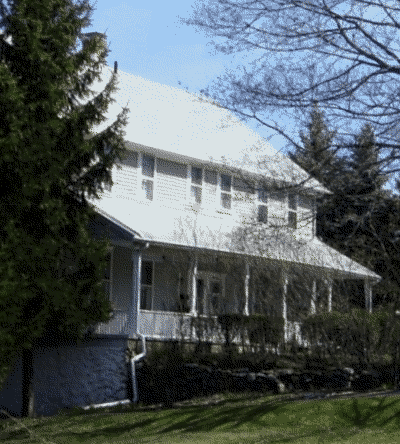
Barn was converted into this home
The Zarcone family continued to grow. Near the end of June 1908, a second son, John, was born to Francesco and Minnie. The month of July brought Giovanni another grandchild, as Mariano and Giovanna also had a son.
Perhaps prompted by arrival of his new grandchildren. Zarcone stepped up work on his large barn-conversion home. The barn, about one hundred and seventy yards east of the existing residence, sat well back from Hospital Avenue and looked out on the peach orchard.
Zarcone contracted with the Seifert and Goos firm of Danbury for construction materials. The first shipment arrived July 27, 1908 – precisely one year before Zarcone's death. Shipments continued until Nov. 7. By that date, Zarcone had racked up a bill of $1,041 (more than $30,000 in 2021) and interest began accruing on his debt. A week later, C. August Seifert and Emil Goos, partners in the building supply company, filed a lien against the Zarcone property.
This seems to be evidence that Giovanni Zarcone, widely regarded as wealthy, was having financial problems one year before his murder. Of course, he had plenty of other things to worry about. His old underworld associates were likely gunning for him. His house was filled to overflowing with his children and grandchildren. And his apparent mistress and his wife were living under the same roof. All of that was in addition to the ordinary day-to-day concerns of the family breadwinner. For a moment, he might have imagined that things couldn't get any worse.
Then, in spring 1909, the Zarcone name appeared again in the newspapers. Giovanni's nephew Pietro, a butcher living on Fourth Avenue in Brooklyn, was arrested April 14 for the killing of racketeer Andrea Gambino.
According to Pietro Zarcone's statement to police, he was confronted by Gambino at five-thirty in the afternoon at the corner of Fourth Avenue and Union Street. Zarcone insisted the two men had never met before. He said Gambino walked up and demanded a payment of $50. Zarcone reached into his hip pocket. Instead of cash, he pulled out a revolver. Gambino also produced a weapon, and the two men began shooting at each other.
Gambino retreated along Union Street to Fifth Avenue. He passed the door to his apartment building on the corner and then ran up Fifth. Zarcone pursued and was joined by two friends, who also fired handguns. After a lengthy gun battle, Gambino finally fell to the sidewalk in front of 155 Fifth Avenue.
Pietro Zarcone and his friends approached the mortally wounded Gambino and pounded his head with the butts of their weapons until a crowd began to gather. The men then ran off.
Police located Pietro Zarcone and arrested him. Zarcone admitted killing Gambino but refused to name the others who joined him in the gunfight. After some investigation, police arrested Zarcone's brother, his butcher shop partner, and two other men.
Though Pietro Zarcone claimed he acted entirely in self-defense, he was held as a murder suspect for several months. Giovanni might have wanted to help his nephew, but there was nothing he could do.
Little is known about Andrea Gambino. After crossing the Atlantic as an adult, he lived for a time on Sackett Street in Brooklyn with his wife and worked as a barber. His father Erasmo, a farmer in Palermo, followed Gambino to the U.S. in 1906. Sometime after that, Andrea Gambino separated from his wife, taking an apartment at the corner of Union and Fifth.
The police believed him to be a leader in Sicilian extortion rackets in the borough. They considered him responsible for the shotgun killing of a man in 1906, but he never stood trial for that crime.
Gambino may have been a distant relative of New York Mafioso Ignazio Lupo. Both men were from the city of Palermo, Gambino's mother's maiden name was Lupo. And Ignazio Lupo's sister married a member of the Gambino family in Palermo.
The possibility of kinship ties between Ignazio Lupo and Andrea Gambino adds greatly to the significance of the gunfight between Gambino and Pietro Zarcone. It could have represented an irreparable split between the Zarcone family and the Morello-Lupo Mafia. A rift of that sort easily could have led to Giovanni Zarcone's shotgun murder fifteen weeks later.
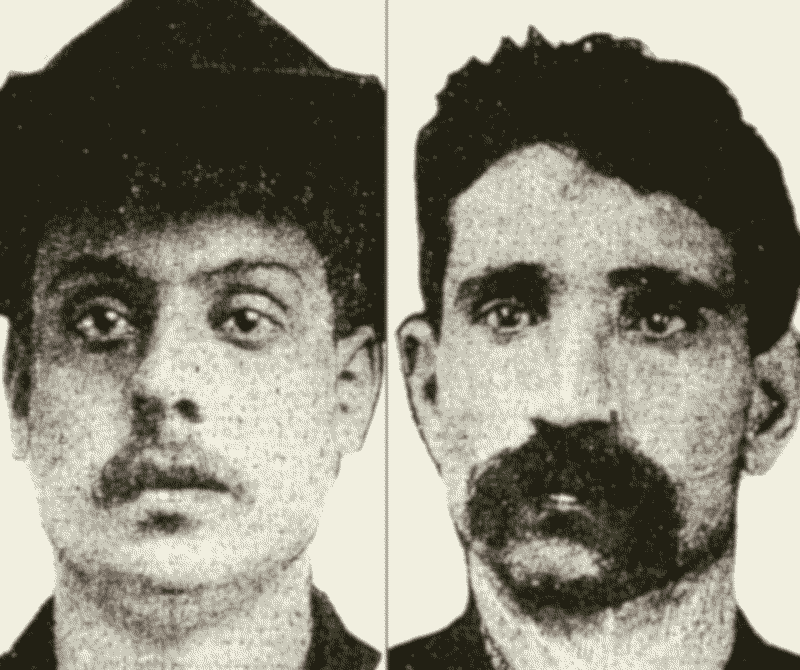
Ignazio Lupo (left) and Giuseppe Morello
News reports of the Giovanni Zarcone murder in Danbury did not discuss the springtime gunfight involving his nephew. Police may have had information on that incident, but police records of the investigation no longer exist.
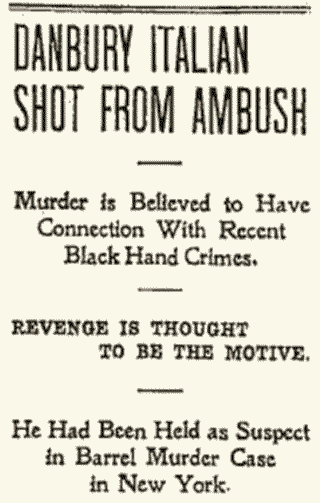
According to reports in the local newspaper, Danbury Police learned that Giovanni Zarcone was shot as he walked home from visiting an ailing niece at the hospital. Zarcone had been visiting this niece regularly since her admission three weeks earlier.
Police concluded that his murderers, aware of his schedule, had been lying in wait behind thick brush along the north side of Hospital Avenue. Relying on the glow of the moon overhead to light their target, they fired an initial volley as Zarcone approached.
Zarcone was wounded by the first shots but not immediately disabled. He cried out and ran for home, losing his hat in the process. Police later found the hat on the road. The gunmen pursued their target, firing as they did so. That scenario was confirmed by three spent shotgun shells police found at the front of the Zarcone property.
Police decided that one of the gunmen must have followed Zarcone all the way to the door of his home. There, the gravely injured victim stumbled and fell. The gunman put his weapon to the side of Zarcone's head, just below the ear, and fired, ending Zarcone's life and causing the terrible head wounds his family members observed seconds later. That final, purposeful shot within easy view of the occupants of the home, according to police, was evidence that the gunmen were willing to accept any risk in order to take Zarcone's life.
Investigators considered various conflicting reports in an effort to determine who the assassins were, where they came from and how they escaped after the shooting.
According to one statement, an unrecognized Italian man was picked up by a Danbury streetcar at the corner of South Street and Town Hill Avenue at about ten-thirty that evening. He rode the streetcar into Bethel. From there he continued on foot southward along the railroad tracks. Police followed the route, questioning locals along the way, but could not identify the man or learn his whereabouts.
Another report indicated that three strange men had been seen looking out the attic window of an abandoned building on Osborne Street. Captain Bradley and several officers went to the site, but found only mice dwelling there.
City Police Officer Patrick Crowe acknowledged spotting three suspicious men at the White Street railroad station on the morning before the murder. They were carrying dismantled shotguns wrapped in newspaper. When he questioned the men, they said they were in town from New York City to hunt for rabbits.
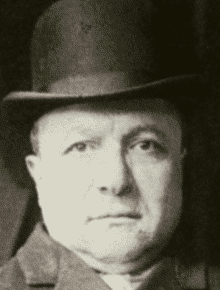
Petrosino
In the afternoon of July 28, Fairfield County Coroner Clifford Wilson traveled to Danbury from Bridgeport, where he lived and worked. No record of Wilson's investigation survives in the Connecticut State Archives or in the archives of the City of Bridgeport.
Wilson served as Bridgeport's acting mayor and president of its common council. His extensive responsibilities at home quickly compelled him to turn the investigation over to Deputy Coroner Henry Stevenson.
At the end of July, a Danbury newspaper article on the Zarcone slaying mentioned a distinguished New York crimefighter who was murdered on assignment in Sicily just four months earlier. The Danbury Evening News stated that Joseph Petrosino – an expert on the Morello Mafia since the Barrel Murder and widely viewed as a law enforcement martyr since his own murder – had visited Danbury on police business back in 1906. Learning that Zarcone had recently become a resident of the city, Petrosino revealed to local police that Zarcone had been connected to the Barrel Murder. He warned, "You are going to have trouble there, for sooner or later they will get him." The Evening News said that Petrosino was referring to a vendetta of the family and friends of Barrel Murder victim Benedetto Madonia.
If this warning actually was issued back in 1906, it also could help explain how police and newspapers so quickly connected the Zarcone death to the Barrel Murder. However, the Evening News did not appear entirely convinced of its own story. It did not specify the source of its information on Petrosino's warning. And, it attributed the warning to the great crimefighter with the cautious and skeptical introduction, "Petrosino is alleged to have said..."
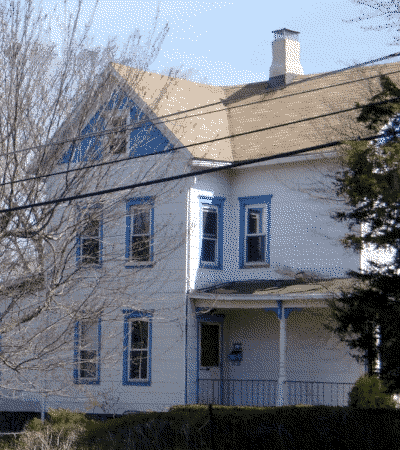
Zarcone home
The authorities came to doubt the initial report of seven people fleeing the Zarcone property after the shooting. Just over two weeks into the investigation, they decided the correct figure was five, including three gunmen and two bystanders - a couple that had been walking together. The unidentified Italian man and woman went to the police on August 13 to report that both of them had been in the vicinity of the Zarcone home at the time of the shooting. They had hesitated to reveal their story, fearing the killers might turn on them.
Strolling along Hospital Avenue in the moonlight, the man and woman saw flashes of firearms from the bushes, heard a scream and then saw Zarcone running down the avenue with three men in pursuit. Overwhelming curiosity caused the woman to follow the others. Overwhelming – let's call it "prudence" – caused her escort to drop down and conceal himself in the roadside shadows.
The woman told police she ran into Zarcone's yard and saw Zarcone fall to the ground right in front of her. A gunman approached and bent over the helpless victim. The woman could not say whether Zarcone was shot while he was lying there. She explained that the fright of the moment affected her memory.
She did recall that the gunman stepped toward her. She told police that she cried out, "Don't shoot me. I haven't done anything."
Seemingly convinced by that simple argument, the three attackers regrouped, ran off toward the hospital and disappeared into the bushes near the point of the initial attack. The woman rushed to rejoin her companion, and they quickly left, heading toward Danbury's Germantown neighborhood.
The woman told police that she could not identify any of the gunmen. She said she believed they wore dark cloth over their faces.
While police had little luck finding answers, they did discover a very interesting new question: Just who was that Zarcone niece at the hospital?
For a while, doctors at Danbury Hospital prevented police from telling the woman patient about Zarcone's death, fearing it would harm her health. The doctors broke the news gently. She accepted it without any noticeable ill effects.
When investigators spoke with her at the hospital, they learned her name was Gaetana Giardina and discovered that she was not Zarcone's niece. However, her relationship to him remained unspecified. The police called the Zarcone family in for questioning and spent four hours going over the details of the murder case and the family relationships. The interviews proved unhelpful.
Giovanni Zarcone's widow Giuseppa insisted that family relationships were "entirely harmonious." She said she knew Giardina only through her late husband and accepted Giovanni's statement that Giardina was her sister-in-law, the widow of her deceased brother. She insisted that she had always treated Giardina with the respect that was due her.
There soon was evidence of disharmony in the family, however. When Giardina was released from the hospital early in August, she was not permitted to return to the Zarcone home on Hospital Avenue. Instead, she moved into rooms on Osborne Street. She had little if any interaction with the Zarcones from that moment on.
Over time, rumors surfaced about a love triangle in the Zarcone home. There even was speculation that Giardina's lengthy hospitalization resulted from a clumsy attempt of her own to poison Giuseppa, an effort that Giuseppa detected and managed to reverse. Some thought Giovanni might have been murdered by Giuseppa's relatives acting to defend her honor. It is also conceivable that Giardina's relatives took action against Zarcone for a similar reason. Giardina's unemotional reaction to the murder could be viewed as evidence that the news was neither shocking nor unwelcome.
Following Giardina's release from the hospital, no meaningful progress seems to have been made on the Zarcone murder investigation. Police and Deputy Coroner Stevenson occasionally told the press that they were continuing work on the case, but it was generally regarded as hopeless.
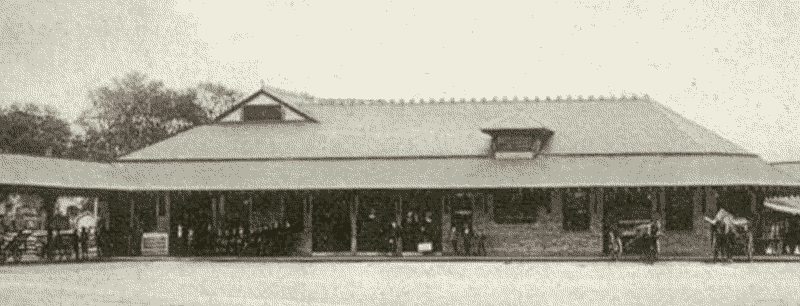
Danbury Railroad Station
Like the other killings related to the infamous Barrel Murder, the Zarcone murder remains unsolved.
Some Zarcone descendants continue to wonder whether Giovanni's love affair might have been the cause. The possibility remains that the relatives of DePrimo and Madonia performed the killing in revenge for the Barrel Murder. That seems less likely in Zarcone's case than in Petto's. At worst, Zarcone only had a peripheral role in the Madonia killing. A feud between the Gambino and Zarcone families is also a possible cause.
The most likely trigger for the Hospital Avenue ambush appears to be an effort by the Morello Mafia organization to eliminate potential informants.
Whoever the killers were, they clearly had knowledge of Zarcone's movements: They knew the timing of his hospital visits and they knew he made those visits alone. It also appears they were at least somewhat acquainted with the Danbury area. They selected an ideal spot for an ambush, and they were able either to escape from the city or to hide within it undetected. These factors would point more easily to members of the Zarcone or Giardina families than to any known member of the Morello-Lupo organization.
One other detail is known of Zarcone's killers: Their behavior was highly professional. Zarcone had sustained severe – probably mortal – wounds and was believed to be either already dead or dying as he collapsed at his doorstep. However, one of the killers stepped into clear view of the Zarcone home and at least two bystanders in order to be absolutely certain of the kill.
If the Morello Mafia executed Zarcone in order to protect itself against prosecution, its efforts were in vain. By the end of 1909, the organization was a shambles. It turned out that had nothing to do with the Barrel Murder that so concerned Morello. Using informants unsuspected even by the extremely cautious boss of bosses, Secret Service Agent William Flynn assembled a convincing counterfeiting case.
Morello, Lupo and six others, who were actively engaged in the production and distribution of counterfeit bills, were arrested in November. All were convicted and sentenced to long terms in Atlanta Federal Penitentiary. Mafia boss of bosses Giuseppe Morello was sentenced to twenty-five years and a $1,000 fine. Ignazio Lupo was sentenced to thirty years and a $1,000 fine. Additional members of the Morello Mafia across the U.S. were rounded up, tried and convicted in the months that followed.

Danbury Hospital
Immediately after Zarcone's death, his son Peter returned to Danbury from Chicago. In early August, Peter, who years earlier made the papers by shooting a snake, was involved in another shooting at the Hospital Avenue home. According to all reports, he accidentally shot himself in the hand with a pistol.
The source of the weapon was not known for certain. Before having surgery at Danbury Hospital, Peter told police that he found the weapon while going through his late father's belongings. However, one of Peter's sisters reported that Peter had brought the pistol with him from Chicago. After surgery, Peter traveled back to his wife Angela in Chicago and resumed his career as a butcher.
Giuseppa Zarcone took her younger children back to Brooklyn, moving into an apartment in the same Washington Avenue building where daughter Minnie and her husband Francesco lived when they first married. Minnie and Francesco also returned to Brooklyn and lived briefly on Nineteenth Street. Francesco was in ill health and died of chronic endocarditis on November 19, 1909. Following his death, Minnie moved back in with her mother and siblings.
Giovanni Zarcone's half-brother, yet another Pietro, established himself as a butcher in Danbury just as his relatives were moving away. Two months after Giovanni's murder, Pietro was married by a Danbury justice of the peace to Annie Spilotros.
In April 1910, Seifert and Goos brought a civil lawsuit against the Zarcone estate. The named defendants included Giuseppa, her children and the C.W Stuart Corporation of Wayne County, New York. The Stuart firm was a supplier of fruit trees and berry bushes. It isn't clear what interest C.W. Stuart had in the Zarcone estate. The lawsuit was resolved a short time later as Giuseppa sold the Hospital Avenue property.
While the family home at Hospital Avenue was recently torn down and replaced, the house converted from the old Zarcone barn still stands, set back from the road at the northeast corner of Hospital Avenue and Fifth Street.
Thanks to Matt Nuccio, Marina Riggio, Connecticut State Library Archivist Paul Baran, Danbury Reference Librarian John O'Donnell, Newsday reporter Keiko Morris, Acting Office Supervisor Cynthia Powell and Trooper William F. Tate of the Connecticut Department of Public Safety, Lieutenant Peter Gantert of the Danbury CT Police Department's Community Services Division.
"150 years in all for the Lupo gang," New York Times, Feb. 20, 1910, p. 1.
"30 years for Wolf," Washington Post, Feb. 20, 1910, p. 1.
Astronomical Applications Department, U.S. Naval Observatory, Phases of the Moon
Atlanta Federal Penitentiary prisoner files of Giuseppe Morello and Ignazio Lupo, National Archives and Records Administration.
"Alleged murderer freed," New York Daily Tribune, Dec. 21, 1909, p. 2.
"Another arrest in barrel murder case," New York Times, May 9, 1903.
"Another shocking murder mystery," Reno NV Evening Gazette, July 28, 1909, p. 1.
"Another Zarcone shot," Danbury Evening News, Aug. 6, 1909.
Bailey, James Montgomery, History of Danbury, Conn., 1684-1896, New York: Burr Printing House, 1896, pp. 448-449, 457.
Bridgeport CT Municipal Directory, 1908.
"'Barrel' murder plot and victim known," New York Times, April 21, 1903, p. 1.
"Coiners gang killed him," New York Sun, April 16, 1903, p. 1.
"Counterfeiters' gang is captured," New York Evening World, July 17, 1903, p. 4.
Daily reports of William Flynn, Secret Service, Nov. 15, 1909, p. 4-6.
Danbury CT land records, Sept. 27, 1905, vol. 128, p. 346.
Danbury CT land records, Nov. 13, 1908.
Danbury CT Municipal Directory, 1906, p. 255.
Danbury Historical Society, Images of America: Danbury, Arcadia Publishing, 2001, pp. 8, 29.
"Desperate gang held in murder mystery," New York Times, April 17, 1903, p. 3.
"Eight Sicilians held for barrel murder," New York Times, April 16, 1903, p. 1.
Flynn, William J., "Black Hand inner secrets laid bare: The Barrel Murder mystery solved," Washington Post, April 26, 1914, p. M5.
Flynn, William J. The Barrel Mystery, New York: James A. McCann Company, 1919, pp. 13, 16-17.
Francesco and Domenica Zarcone marriage record, Brooklyn, NY, Jan. 1, 1905.
"Fined for carrying a gun and shooting a snake on Sunday," Statesville NC Landmark, Sept. 25, 1906;
"Fined for killing a snake on Sunday," Oakland CA Tribune, Sept. 27, 1906, p. 7.
"Fined for protecting self," Alexandria VA Gazette, Sept. 21, 1906, p. 1.
"Fifth murder in 'Barrel Mystery,'" Chicago Daily Tribune, July 29, 1909, p. 7.
"Freed of murder charge," New York Times, Dec. 21, 1909, p. 11.
Ignazio Francis Giardina World War I Draft Registration, No. 3689, Sept. 12, 1918.
Ignazio Francis Giardina World War II Draft Registration, No. 2886, 1942.
"Investigation still on," Danbury News, Aug. 11, 1909.
"Italian farmer assassinated," Fitchburg MA Daily Sentinel, July 28, 1909.
"Kill fourth man in Barrel Murder," New York Times, July 29, 1909, p. 2.
"Killed and packed in barrel," New York Sun, April 15, 1903, p. 1.
"Kills Black Hand man," New York Tribune, April 15, 1909, p. 1.
"Kills snake on Sunday," Paducah KY Evening Sun, Sept. 24, 1906, p. 4.
"Mafia murder victim," New York Tribune, April 15, 1909, p. 1.
"Mafia protects men who cut up body of victim," New York Evening World, Feb. 22, 1908, p. 2.
"Man in barrel was tortured, then murdered," New York Evening World, April 14, 1903, p. 1.
"Murdered man's body found in a barrel," New York Times, April 15, 1909, p. 2.
"Murdered man's son shot," Hartford Courant, Aug. 7, 1909, p. 13.
"Mysterious murder credited to Mafia," Washington Times, April 16, 1903, p. 1.
"No trace of murderers," Danbury CT Evening News, July 30, 1909.
Passenger manifest of the S.S. Calabria, arrived New York City on June 11, 1901.
Passenger manifest of the S.S. Palatia, arrived New York City on April 16, 1903.
Passenger manifest of the S.S. Prinz Adalbert, arrived New York City on Aug. 6, 1906
Passenger manifest of the S.S. Roma, arrived New York City on July 7, 1902.
Petacco, Arrigo, translated by Charles Lam Markmann, Joe Petrosino, New York: Macmillan Publishing Co., 1974, p. 147-153, 180-181.
Pitkin, Thomas Monroe and Francesco Cordasco, The Black Hand: A Chapter in Ethnic Crime, Totowa, NJ: Littlefield, Adams & Co., 1977, p. 49.
"Petrosino slain, assassins gone," New York Times, March 14, 1909, p. 1.
"Petrosino's prediction," Danbury Evening News, July 29, 1909.
"Petto is indicted for Barrel Murder," New York Evening World, June 25, 1903, p. 2.
"Police are certain they have slayers," New York Evening World, April 16, 1903, p. 1.
Report of Commissioner-General of Immigration, 1904, p. 122.
"Revenge on Black Hand," Washington Post, Oct. 26, 1905, p. 1.
"Search for murderer," Bridgeport CT Post, July 28, 1909.
"Seven Italians held," New York Tribune, May 9, 1903, p. 6
"Seven now held in Barrel Case," New York Evening World, May 9, 1903, p. 2.
"Shot dead in street fight," New York Sun, April 15, 1909, p. 2.
"Shot snake Sunday, fined ten dollars," Washington Times, Sept. 24, 1906, p. 2.
"Six held in Mafia case," New York Evening World, May 8, 1903, p. 1.
"Soldiers hunt for murderers," Danbury CT News, July 28, 1909.
"Suspects were seen with barrel murder victim," New York Evening World, April 18, 1903, p. 1.
"'The Ox' goes free in Barrel Murder," New York Evening World, Jan. 29, 1904, p. 2.
"'The Ox' leaves town," New York Tribune, Jan. 31, 1904, p. 7.
"'The Ox' may yet be put on trial," New York Evening World, Feb. 3, 1904, p. 5.
"The Ox wanted, but has escaped," New York Evening World, Jan. 30, 1904, p. 5.
"The slayers of Zarcone," Danbury Evening News, Aug. 16, 1909
"The Zarcone murder: Authorities have obtained no trace of assassins," Danbury News, Aug. 4, 1909.
"Think they have murderers," New York Tribune, April 16, 1903, p. 1.
United States Census of 1910.
"Victim kills Black Hander," New York Times, April 15, 1909, p. 1.